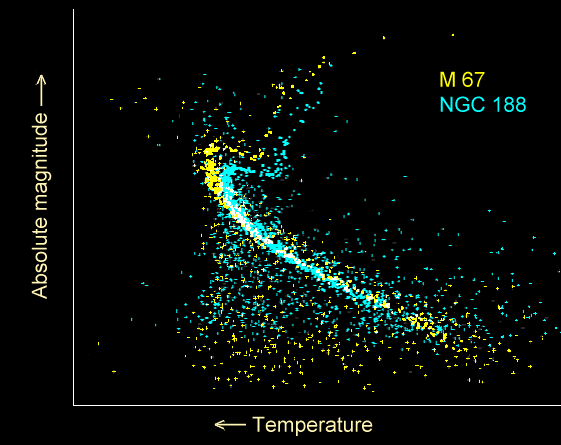 |
This is a file from the Wikimedia Commons. Information from its description page there is shown below.
Commons is a freely licensed media file repository. You can help.
|
 |
This image was (or all images in this article or category were) uploaded in the GIF format, while a different format would have been more suitable. Commons discourages the use of GIF files, except for animations. See Commons:File types for more information. If possible, please upload a PNG version (or JPEG for some photos) of this image, and mark the GIF image as {{ superseded|Image:new image name}}. If you like, encourage other Wikimedia projects using the GIF to use the new version instead.
If this image is a diagram or other image suitable for vectorisation, please tag this image with {{ convert to SVG}} instead of {{ badGIF}}. If not suitable for vectorisation, use {{ convert to PNG}}.
|
Summary
| DescriptionOpen cluster HR diagram ages.gif |
English: HR diagrams for two open clusters, showing the main sequence turn-off at different ages.
|
| Date |
|
| Source |
Own work |
| Author |
Created by User:Worldtraveller |
Reference
- Richmond, Michael (2004-12-28). Estimating Distances across our Galaxy. Rochester Institute of Technology. Retrieved on 2008-11-29.—See the two plots near the end of the page.
- Maeder, André (1974). " Stellar evolution near the main sequence: on some systematic differences between cluster sequences and model calculations.". Astronomy & Astrophysics 32: 177–190. Retrieved on 2008-11-28.
Licensing
 |
Permission is granted to copy, distribute and/or modify this document under the terms of the GNU Free Documentation License, Version 1.2 or any later version published by the Free Software Foundation; with no Invariant Sections, no Front-Cover Texts, and no Back-Cover Texts. A copy of the license is included in the section entitled GNU Free Documentation License. http://www.gnu.org/copyleft/fdl.htmlGFDLGNU Free Documentation Licensetruetrue
|
File usage
The following pages on Schools Wikipedia link to this image (list may be incomplete):
Schools Wikipedia was created by children's charity SOS Childrens Villages. SOS Children is famous for the love and shelter it brings to lone children, but we also support families in the areas around our Children's Villages, helping those who need us the most. Want to learn more? Go to http://www.soschildrensvillages.org.uk/sponsor-a-child




